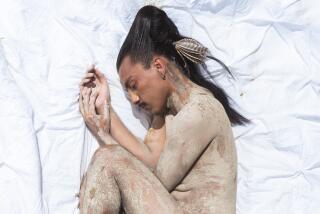Review: The ghosts of Mexico’s missing women animate Judithe Hernández’s brooding debut at the Museum of Latin American Art
Lotería is to the pastel drawings of Judithe Hernández what the I Ching was to John Cage’s avant-garde music after World War II or the “Three Standard Stoppages” were to the Dada objects of Marcel Duchamp a century ago.
As a representation of inherent chance and life’s indeterminacy, the emblematic forms found in a lotería deck of cards — rose, devil, sun, deer and many more — are an inspiration for the archetypal style commonly encountered in Hernández’s drawings. The structure and appearance of her work could not be more different from a Duchamp or a Cage, but an awareness of chance as an inescapable feature of attentive living is shared.
Twenty-one drawings are on view in “Judithe Hernández: A Dream Is the Shadow of Something Real” at the Museum of Latin American Art in Long Beach, accompanied by a small selection of preparatory sketches in pencil and ink, a few published graphics, some snapshots and other ephemera. Organized by curator Edward Hayes, it is the first solo exhibition by a Chicana artist in the museum’s 22-year history.
The show was inspired by MOLAA’s acquisition of “Maidens of the Barrio,” Hernández’s 2013 reworking of “Les Demoiselles d’Avignon,” Picasso’s 1907 opening salvo in the Cubist revolution. Her large, two-panel drawing isn’t as visually riveting as Picasso’s masterpiece, whose shattered image of Barcelona brothel workers is sexually fraught; but it does compile many Chicana feminist themes that have long animated Hernández’s brooding work.
The earliest in the show — a tentatively drawn picture of a young woman seen in profile backed by a massive bunch of flowers and with a glowing moon before her — dates from 1974-78, a few years after the artist’s graduate studies with the estimable draftsman Charles White at the Otis College of Art and Design. Seventeen of the drawings are from the last 10 years, while the most recent are the most consistently powerful.
Eyes closed, face softly illuminated by moonlight, a young woman wearing a vividly colored, flower-embroidered Mexican tunic hovers horizontally over a landscape in “The Unknown Saint” (2017). The two-panel composition, more than seven feet wide, is a pointed recollection of another masterpiece — John Everett Millais’ Pre-Raphaelite “Ophelia” from 1851-52.
The Mexican woman’s tragedy is not Ophelia’s, however, and certainly not Hamlet’s, that melancholic man without whom the woman’s story would not exist. Rather than a drowned body floating serenely in a stream, a victim driven out of her mind when her father is killed by her lover, this anonymous body floats in fluid space above an arid expanse of dusty desert.
Behind the figure and rising above her body, a row of spiny cactuses visually impales the now-serene young woman as if on a bed of nails. A crimson ribbon winds around her throat, left by a mysterious hand exiting stage left.
Forget dubious Shakespearean tropes of hysteria and female insanity. This is a martyr, an Everywoman sacrificed on an altar of survival. The imposing drawing is as theatrical as a Counter-Reformation Baroque painting.
Hernández transforms the play’s character, who in recent decades has become a feminist heroine signifying social rebellion, into something at once spectral and topical. Often, she creates drawings in a series, and “The Unknown Saint” is from a lengthy meditation on the unsolved abductions and slayings of hundreds of girls and women working in the maquiladoras around the Mexican border city of Juárez.
Women are Hernández’s primary subject.
In “The Black Hand,” from 1983, a sensuously drawn bust of a woman set against a chrome-yellow plane is woven into a lush foreground screen of giant blue and green leaves. The vivid garden casts a smoky shadow across her face, completely obscuring her eyes. She’s a mysterious Eve, vibrant and fierce.
Thirty-two years later, a tiny baby girl in a white costume suggestive of a Communion dress is shown laid out in deathly repose and wrapped in the colors of the Mexican flag. A banner coiled around her hand reads, “We Come but to Dream.”
Another exquisite recent drawing shows a female nude floating on lily pads before a full moon, as a moray eel, rainbow-colored, swims by. Facing her, the show’s only male image turns up — a lithe fellow in royal blue cast as a masked predator.
The literary dimension of Hernández’s art is churned by her marvelous color sense, which unmoors any illustrative limits of the genre. (Wittily, in a video interview, the artist compares her fluency in pastel mark-making with any modern woman’s practiced skill with cosmetics.) In most every instance, black paper is the light-absorbent support for intense color, setting off chromatic displays like fireworks against a night sky.
Nighttime likewise falls over the show’s evocative title. “A Dream Is the Shadow of Something Real” is a line spoken by a male aboriginal protagonist in Peter Weir’s apocalyptic 1977 film, “The Last Wave.” Hernández’s best drawings are similarly sensuous and discomfiting, but the compelling visual dialect is distinctly feminist.
Twitter: @KnightLAT
More to Read
The biggest entertainment stories
Get our big stories about Hollywood, film, television, music, arts, culture and more right in your inbox as soon as they publish.
You may occasionally receive promotional content from the Los Angeles Times.











